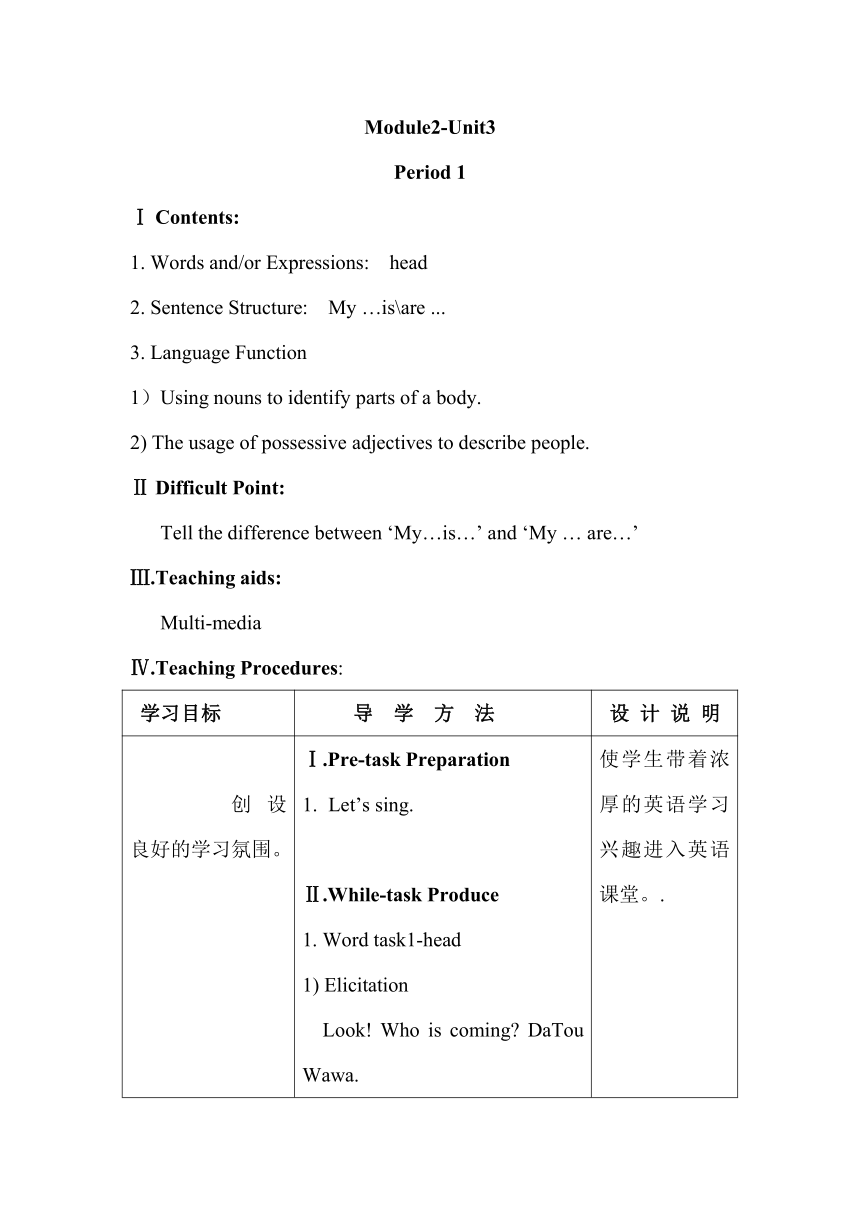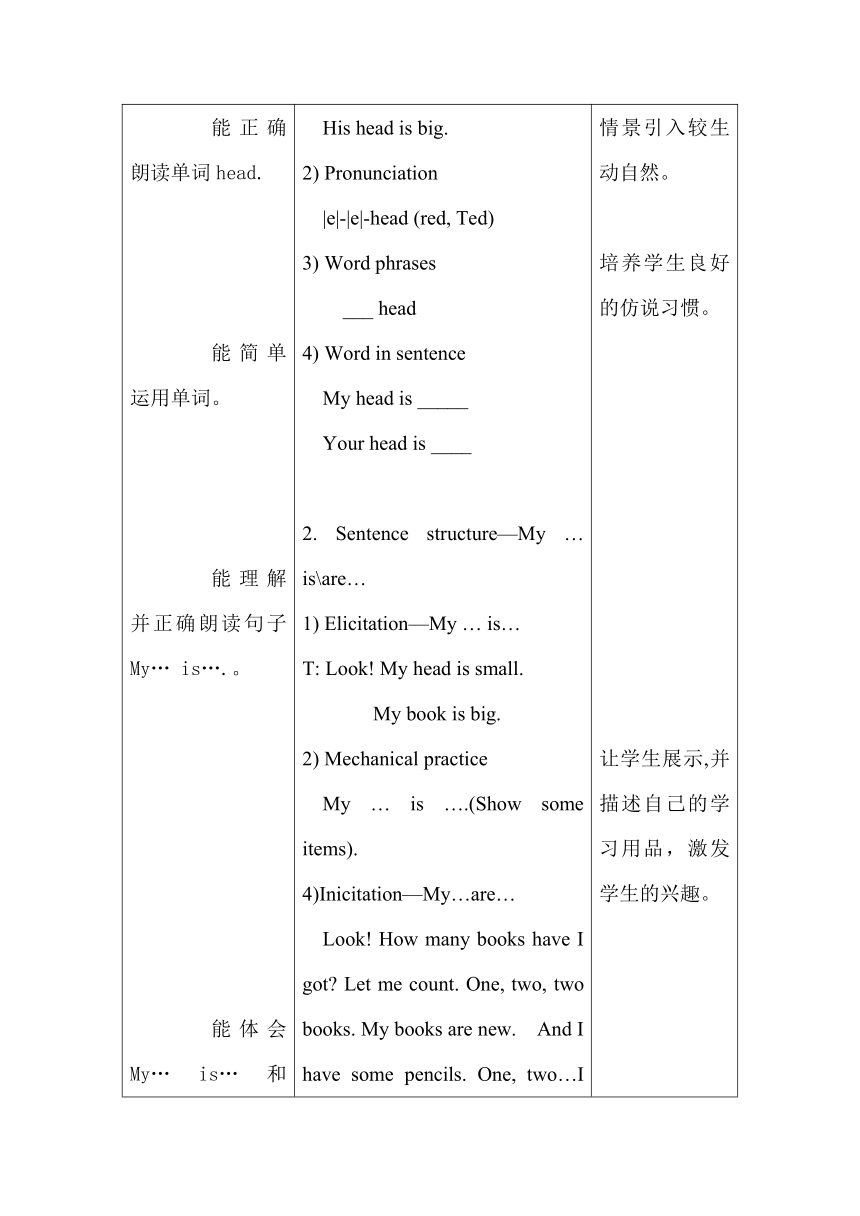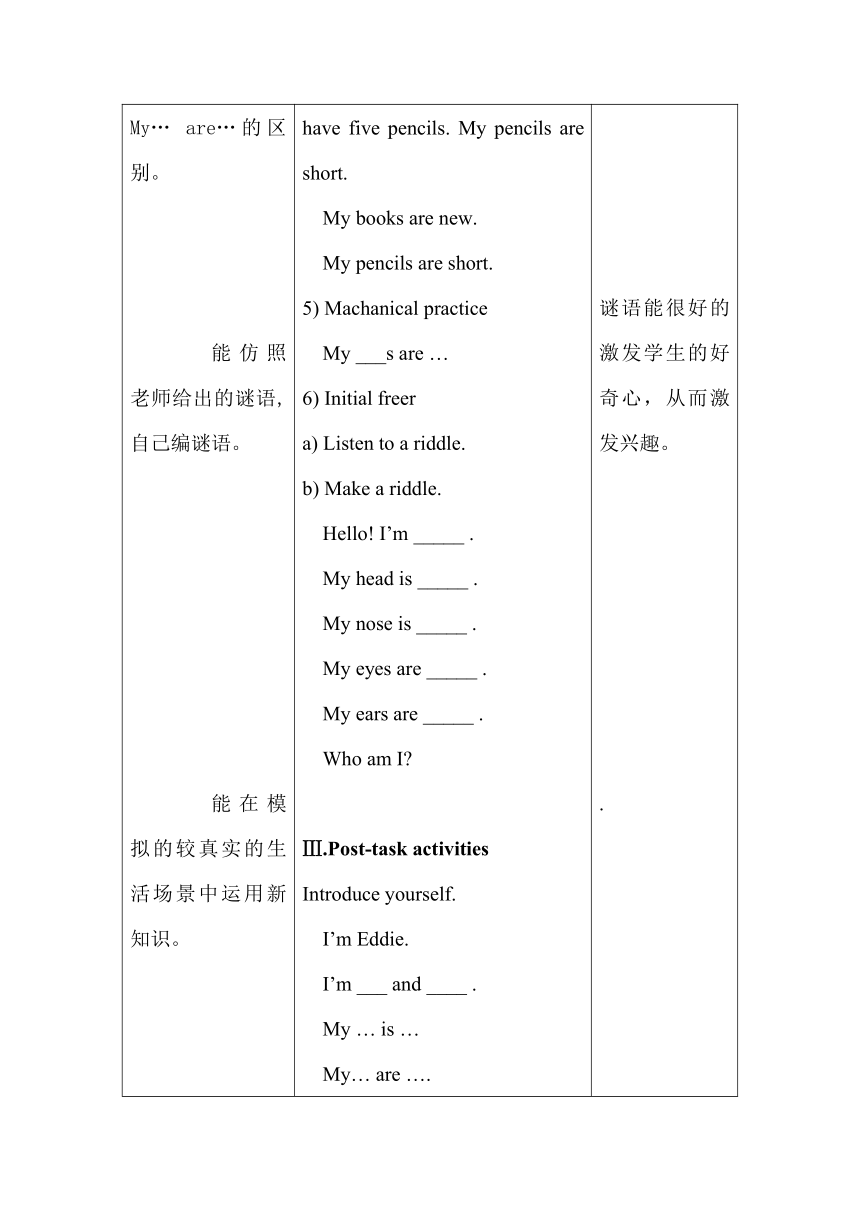Unit 6 My hair is short 教案
文档属性
| 名称 | Unit 6 My hair is short 教案 |  | |
| 格式 | zip | ||
| 文件大小 | 121.3KB | ||
| 资源类型 | 教案 | ||
| 版本资源 | 牛津深圳版 | ||
| 科目 | 英语 | ||
| 更新时间 | 2017-12-09 19:06:44 | ||
图片预览




文档简介
Module2-Unit3
Period
1
Ⅰ
Contents:
1.
Words
and/or
Expressions:
head
2.
Sentence
Structure:
My
…is\are
...
3.
Language
Function
1)Using
nouns
to
identify
parts
of
a
body.
2)
The
usage
of
possessive
adjectives
to
describe
people.
Ⅱ
Difficult
Point:
Tell
the
difference
between
‘My…is…’
and
‘My
…
are…’
Ⅲ.Teaching
aids:
Multi-media
Ⅳ.Teaching
Procedures:
学习目标
导
学
方
法
设
计
说
明
创设良好的学习氛围。能正确朗读单词head.能简单运用单词。能理解并正确朗读句子My…
is….。能体会My…
is…
和My…
are…的区别。能仿照老师给出的谜语,自己编谜语。能在模拟的较真实的生活场景中运用新知识。
Ⅰ.Pre-task
PreparationLet’s
sing.Ⅱ.While-task
Produce1.
Word
task1-head1)
Elicitation
Look!
Who
is
coming
DaTou
Wawa.
His
head
is
big.2)
Pronunciation
|e|-|e|-head
(red,
Ted)3)
Word
phrases
___
head4)
Word
in
sentence
My
head
is
_____
Your
head
is
____2.
Sentence
structure—My
…
is\are…1)
Elicitation—My
…
is…T:
Look!
My
head
is
small.
My
book
is
big.2)
Mechanical
practice
My
…
is
….(Show
some
items).4)Inicitation—My…are…
Look!
How
many
books
have
I
got
Let
me
count.
One,
two,
two
books.
My
books
are
new.
And
I
have
some
pencils.
One,
two…I
have
five
pencils.
My
pencils
are
short.
My
books
are
new.
My
pencils
are
short.5)
Machanical
practice
My
___s
are
…6)
Initial
freera)
Listen
to
a
riddle.b)
Make
a
riddle.
Hello!
I’m
_____
.
My
head
is
_____
.
My
nose
is
_____
.
My
eyes
are
_____
.
My
ears
are
_____
.
Who
am
I Ⅲ.Post-task
activitiesIntroduce
yourself.
I’m
Eddie.
I’m
___
and
____
.
My
…
is
…
My…
are
….
使学生带着浓厚的英语学习兴趣进入英语课堂。.情景引入较生动自然。培养学生良好的仿说习惯。让学生展示,并描述自己的学习用品,激发学生的兴趣。谜语能很好的激发学生的好奇心,从而激发兴趣。.
Period
2
Ⅰ
Contents:
1.
Words
and/or
Expressions
hair
2.
Sentence
Structure
Your
…is\are
...
3.
Language
Function
1)Using
nouns
to
identify
parts
of
a
body.
2)
The
usage
of
possessive
adjectives
to
describe
people.
Ⅱ
Difficult
Point:
Tell
the
difference
between
‘Your…
is…’
and
‘Your…are…’.
Ⅲ.Teaching
aids:
Multi-media
Ⅳ.Teaching
Procedures:
学习目标
导
学
方
法
设
计
说
明
创设良好的学习氛围。能理解并能正确朗读句子。能熟练地朗读句子。能在模拟场景中运用句子。能在较真实的场景中观察并描述同学的外貌。能简单区分运用第一第而人称的句型。
Ⅰ.Pre-task
Preparation.1.
Sing
a
song.2.
Say
a
rhyme.Ⅱ.While-task
Produce1.
Word
task1—hair1)
Elicitation
T:
Look!
My
hair
is
long.
Your
hair
is
short.
My
hair
is
soft.
And
your
hair
is
hard.2)
Pronunciation
chair—hair3)
A
chant
Hair,
hair,
my
hair.
Hair,
hair,
your
hair.
Hair,
hair,
long
hair.
Hair,
hair,…4)
Word
in
sentence
My
hair
is…
Your
hair
is….2.
Sentence
structure—Your…
is\are…1)
Elicitation
T:
Head,
head
S1:One
head
T:
your
head
is
small
T:
eyes,
eyes
S1:two
eyes
T:
Your
eyes
are
big.2)Sounds
&
TonesYour
head
is
small.Your
eyes
are
big.3)
Mechanical
practice
Play
the
game
with
deskmate.4)
Initial
Freer
Draw
a
picture
of
your
good
friend
and
talk
about
it.
Look!
You
are
a
boy.
Your
hair
is…
Your
face
is…
Your
eyes
are…
And
your
ears
are…
I
like
you.5)
Ask
and
answer—About
you
and
me
A:
Look!
My
nose
is
small.
B:
My
nose
is
big.
A:
No.
Your
nose
is
not
very
big.Ⅲ.Post-task
activitiesLet’s
act.A:
I’m
a
chick.B:
Yes,
you
are
a
chick.A:
My
eyes
are
black.B:
Your
eyes
are
black.A:
I
can
run.B:
You
can
run.Act
as
a
wolf,
a
panda
etc.
使学生带着浓厚的英语学习兴趣进入英语课堂。.在情景中引入较自然。以培养学生良好的仿说习惯。让学生在拍拍说说中感知语言,学习语言。游戏符合低年级学生的年龄特点,学生在快乐的游戏中感知语言,学习语言。较真实的场景的创设能帮助学生发展他们的语言技能。扮演小动物能激发学生的学习兴趣。.
Notes:
能正确朗读单词head.
能理解并正确朗读句子My…
is….。
能体会My…
is…
和My…
are…的区别。
Period
1
Ⅰ
Contents:
1.
Words
and/or
Expressions:
head
2.
Sentence
Structure:
My
…is\are
...
3.
Language
Function
1)Using
nouns
to
identify
parts
of
a
body.
2)
The
usage
of
possessive
adjectives
to
describe
people.
Ⅱ
Difficult
Point:
Tell
the
difference
between
‘My…is…’
and
‘My
…
are…’
Ⅲ.Teaching
aids:
Multi-media
Ⅳ.Teaching
Procedures:
学习目标
导
学
方
法
设
计
说
明
创设良好的学习氛围。能正确朗读单词head.能简单运用单词。能理解并正确朗读句子My…
is….。能体会My…
is…
和My…
are…的区别。能仿照老师给出的谜语,自己编谜语。能在模拟的较真实的生活场景中运用新知识。
Ⅰ.Pre-task
PreparationLet’s
sing.Ⅱ.While-task
Produce1.
Word
task1-head1)
Elicitation
Look!
Who
is
coming
DaTou
Wawa.
His
head
is
big.2)
Pronunciation
|e|-|e|-head
(red,
Ted)3)
Word
phrases
___
head4)
Word
in
sentence
My
head
is
_____
Your
head
is
____2.
Sentence
structure—My
…
is\are…1)
Elicitation—My
…
is…T:
Look!
My
head
is
small.
My
book
is
big.2)
Mechanical
practice
My
…
is
….(Show
some
items).4)Inicitation—My…are…
Look!
How
many
books
have
I
got
Let
me
count.
One,
two,
two
books.
My
books
are
new.
And
I
have
some
pencils.
One,
two…I
have
five
pencils.
My
pencils
are
short.
My
books
are
new.
My
pencils
are
short.5)
Machanical
practice
My
___s
are
…6)
Initial
freera)
Listen
to
a
riddle.b)
Make
a
riddle.
Hello!
I’m
_____
.
My
head
is
_____
.
My
nose
is
_____
.
My
eyes
are
_____
.
My
ears
are
_____
.
Who
am
I Ⅲ.Post-task
activitiesIntroduce
yourself.
I’m
Eddie.
I’m
___
and
____
.
My
…
is
…
My…
are
….
使学生带着浓厚的英语学习兴趣进入英语课堂。.情景引入较生动自然。培养学生良好的仿说习惯。让学生展示,并描述自己的学习用品,激发学生的兴趣。谜语能很好的激发学生的好奇心,从而激发兴趣。.
Period
2
Ⅰ
Contents:
1.
Words
and/or
Expressions
hair
2.
Sentence
Structure
Your
…is\are
...
3.
Language
Function
1)Using
nouns
to
identify
parts
of
a
body.
2)
The
usage
of
possessive
adjectives
to
describe
people.
Ⅱ
Difficult
Point:
Tell
the
difference
between
‘Your…
is…’
and
‘Your…are…’.
Ⅲ.Teaching
aids:
Multi-media
Ⅳ.Teaching
Procedures:
学习目标
导
学
方
法
设
计
说
明
创设良好的学习氛围。能理解并能正确朗读句子。能熟练地朗读句子。能在模拟场景中运用句子。能在较真实的场景中观察并描述同学的外貌。能简单区分运用第一第而人称的句型。
Ⅰ.Pre-task
Preparation.1.
Sing
a
song.2.
Say
a
rhyme.Ⅱ.While-task
Produce1.
Word
task1—hair1)
Elicitation
T:
Look!
My
hair
is
long.
Your
hair
is
short.
My
hair
is
soft.
And
your
hair
is
hard.2)
Pronunciation
chair—hair3)
A
chant
Hair,
hair,
my
hair.
Hair,
hair,
your
hair.
Hair,
hair,
long
hair.
Hair,
hair,…4)
Word
in
sentence
My
hair
is…
Your
hair
is….2.
Sentence
structure—Your…
is\are…1)
Elicitation
T:
Head,
head
S1:One
head
T:
your
head
is
small
T:
eyes,
eyes
S1:two
eyes
T:
Your
eyes
are
big.2)Sounds
&
TonesYour
head
is
small.Your
eyes
are
big.3)
Mechanical
practice
Play
the
game
with
deskmate.4)
Initial
Freer
Draw
a
picture
of
your
good
friend
and
talk
about
it.
Look!
You
are
a
boy.
Your
hair
is…
Your
face
is…
Your
eyes
are…
And
your
ears
are…
I
like
you.5)
Ask
and
answer—About
you
and
me
A:
Look!
My
nose
is
small.
B:
My
nose
is
big.
A:
No.
Your
nose
is
not
very
big.Ⅲ.Post-task
activitiesLet’s
act.A:
I’m
a
chick.B:
Yes,
you
are
a
chick.A:
My
eyes
are
black.B:
Your
eyes
are
black.A:
I
can
run.B:
You
can
run.Act
as
a
wolf,
a
panda
etc.
使学生带着浓厚的英语学习兴趣进入英语课堂。.在情景中引入较自然。以培养学生良好的仿说习惯。让学生在拍拍说说中感知语言,学习语言。游戏符合低年级学生的年龄特点,学生在快乐的游戏中感知语言,学习语言。较真实的场景的创设能帮助学生发展他们的语言技能。扮演小动物能激发学生的学习兴趣。.
Notes:
能正确朗读单词head.
能理解并正确朗读句子My…
is….。
能体会My…
is…
和My…
are…的区别。
同课章节目录
- Module 1 Getting to know you
- Unit 1 Good morning
- Unit 2 I'm Danny
- Unit 3 Are you Alice?
- Revision 1
- Module 2 My family, my friends and me
- Unit 4 Can you swim?
- Unit 5 That's my family
- Unit 6 My hair is short
- Revision 2
- Module 3 Places and activities
- Unit 7 In the playground
- Unit 8 In my room
- Unit 9 Dinner is ready
- Revision 3
- Module 4 The world around us
- Unit 10 In the sky
- Unit 11 In the forest
- Unit 12 In the street
- Revision 4
